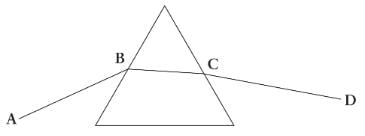Test: Light and Electromagnetic Radiation - MCAT MCQ
10 Questions MCQ Test - Test: Light and Electromagnetic Radiation
If a light ray has a frequency of 5.0 × 1014 Hz, in which region of the electromagnetic spectrum is it located?
An object is placed at the center of curvature of a concave mirror. Which of the following is true about the image?
A ray of light (f = 5 × 1014 Hz) travels from air into crystal into chromium. If the indices of refraction of air, crystal, and chromium are 1, 2, and 3, respectively, and the incident angle is 30°, then which of the following describes the frequency and the angle of refraction in the chromium?
Which phenomenon would cause monochromatic light entering the prism along path AB to leave along path CD?

A submarine is inspecting the surface of the water with a laser that points from the submarine to the surface of the water and through the air. At what angle will the laser not penetrate the surface of the water but rather reflect entirely back into the water? (Assume nwater = 1.33 and nair = 1.)
Which of the following are able to produce a virtual image?
I. Convex lens
II. Concave lens
III. Plane mirror
A scientist looks through a microscope with two thin lenses with m1 = 10 and m2 = 40. What is the overall magnification of this microscope?
Which of the following will not result in the splitting of white light into its component colors?
A child stands between two mirrors with his arms out, perpendicular to the mirrors. One plane mirror is 5 m away from his left hand and another plane mirror is 7 m away from his right hand. How far apart are the two images produced by the mirrors if the child has an arm span of 0.5 m?
When monochromatic light is refracted as it passes from air to glass, which of the following does NOT remain the same? (Note: Assume that the wave is fully transmitted.)






 48.59° is the exact answer.
48.59° is the exact answer.















